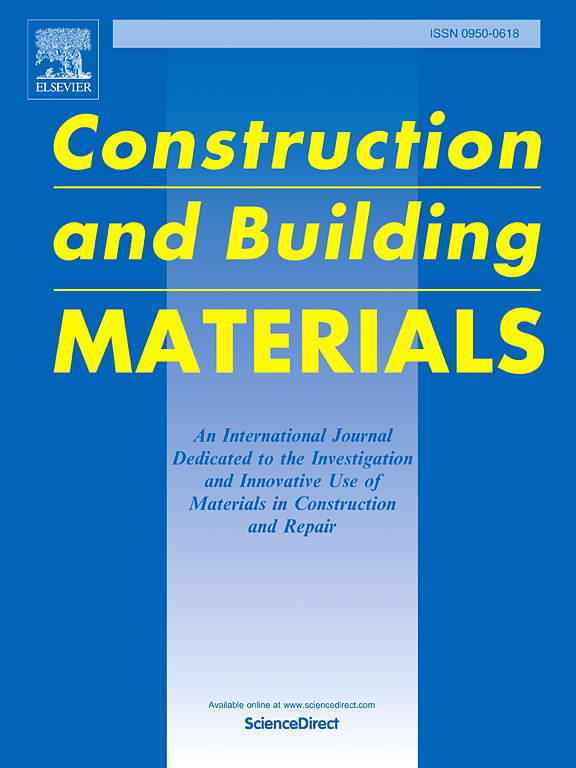Activity characteristics and activation mechanism of molybdenum tailings under mechanical, mechano-thermal, mechano-chemical, and mechano-thermal-chemical activation
IF 7.4
1区 工程技术
Q1 CONSTRUCTION & BUILDING TECHNOLOGY
引用次数: 0
Abstract
Molybdenum tailings (Ms) are a kind of tailings with high crystallinity, and improving their activity using a single activation method is challenging. Existing studies mainly focus on the activation of Ms by specific activation methods. However, few studies compare Ms activity differences and activation mechanisms under different activation methods. To make up for the shortcomings of this research field and improve the utilization efficiency of Ms, the mechanical, mechano-chemical, mechano-thermal, and mechano-thermal-chemical activation were performed to activate Ms. The physicochemical properties of Ms under different activation methods were systematically analyzed. The results showed that mechanical, thermal, and chemical activation could synergistically enhance the activity of Ms. After mechano-thermal-chemical activation, the activity index of Ms was the highest, which was 34.1 % and 16.8 % higher than that of unactivated and mechanical activation, respectively. Adding CaO can weaken the agglomeration force among Ms particles and improve the grinding efficiency. Compared with mechanical activation, the D50 of mechanical-chemical activated Ms was reduced by 36.2 %, and the specific surface area was increased by 34.1 %. Compared with mechano-thermal activation, mechano-chemical activation helped improve the amorphization of quartz, orthoclase, and pyrite, which increased by 10.7 %, 13.6 %, and 83.2 %, respectively. It also helped destroy the Si-O bond, increasing the active Si content by 13.2 %. Compared with mechano-chemical activation, mechano-thermal activation helped improve the amorphization of phlogopite and hornblende, which increased by 13.8 % and 34.8 %, respectively. It also helped destroy the Al-O bond, and the active Al content increased by 78.0 %.
钼尾矿在机械活化、机械-热活化、机械-化学活化和机械-热-化学活化下的活性特征及活化机理
钼尾矿是一种高结晶度的尾矿,用单一的活化方法提高钼尾矿的活性具有一定的挑战性。现有的研究主要集中在通过特异性激活方法激活Ms。然而,很少有研究比较不同激活方法下Ms的活性差异和激活机制。为弥补本研究领域的不足,提高Ms的利用效率,对Ms进行了机械活化、机械-化学活化、机械-热活化和机械-热-化学活化,系统分析了Ms在不同活化方法下的理化性质。结果表明,机械、热、化学活化均能协同增强Ms的活性,机械、热、化学活化后Ms的活性指数最高,分别比未活化和机械活化时高34.1% %和16.8 %。添加CaO可以减弱颗粒间的团聚力,提高磨矿效率。与机械活化相比,机械化学活化Ms的D50降低了36.2% %,比表面积增加了34.1% %。与机械-热活化相比,机械-化学活化改善了石英、正长石和黄铁矿的非晶化,分别提高了10.7 %、13.6 %和83.2 %。它还有助于破坏Si- o键,使活性Si含量提高13.2 %。与机械-化学活化相比,机械-热活化促进了云母和角闪石的非晶化,分别提高了13.8 %和34.8 %。它还有助于破坏Al- o键,活性Al含量提高了78.0 %。
本文章由计算机程序翻译,如有差异,请以英文原文为准。
求助全文
约1分钟内获得全文
求助全文
来源期刊

Construction and Building Materials
工程技术-材料科学:综合
CiteScore
13.80
自引率
21.60%
发文量
3632
审稿时长
82 days
期刊介绍:
Construction and Building Materials offers an international platform for sharing innovative and original research and development in the realm of construction and building materials, along with their practical applications in new projects and repair practices. The journal publishes a diverse array of pioneering research and application papers, detailing laboratory investigations and, to a limited extent, numerical analyses or reports on full-scale projects. Multi-part papers are discouraged.
Additionally, Construction and Building Materials features comprehensive case studies and insightful review articles that contribute to new insights in the field. Our focus is on papers related to construction materials, excluding those on structural engineering, geotechnics, and unbound highway layers. Covered materials and technologies encompass cement, concrete reinforcement, bricks and mortars, additives, corrosion technology, ceramics, timber, steel, polymers, glass fibers, recycled materials, bamboo, rammed earth, non-conventional building materials, bituminous materials, and applications in railway materials.
 求助内容:
求助内容: 应助结果提醒方式:
应助结果提醒方式:


